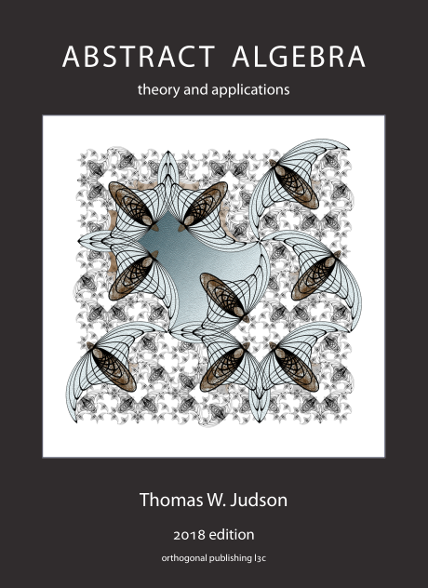Section 4.3 Ring Homomorphisms
A homomorphism between rings is a function which preserves the operations of addition and multiplication in the ring. More specifically, if \(R\) and \(S\) are rings, then a ring homomorphism is a map \(\phi : R \rightarrow S\) satisfying
\begin{align*}
\phi( a + b ) & = \phi( a ) + \phi(b)\\
\phi( a b ) & = \phi( a) \phi(b)\\
\phi(1_R) & = 1_S
\end{align*}
for all \(a, b \in R\text{.}\) If \(\phi \colon R \rightarrow S\) is a one-to-one and onto homomorphism, then \(\phi\) is called an isomorphism of rings and \(R\) and \(S\) are called isomorphic.
Example 4.19.
For any integer \(n\) we can define a ring homomorphism \(\phi : {\mathbb Z} \rightarrow {\mathbb Z}_n\) by \(a \mapsto a \pmod{n}\text{.}\) This is indeed a ring homomorphism, since
\begin{align*}
\phi( a + b ) & = (a + b) \pmod{n}\\
& = a \pmod{n} + b \pmod{n}\\
& = \phi( a ) + \phi(b)
\end{align*}
and
\begin{align*}
\phi( a b ) & = ab \pmod{n}\\
& = a \pmod{n}\cdot b \pmod{n}\\
& = \phi( a ) \phi(b).
\end{align*}
The kernel of the homomorphism \(\phi\) is \(n {\mathbb Z}\text{.}\)
Example 4.20.
Let
\(C[a, b]\) be the ring of continuous real-valued functions on an interval
\([a,b]\) as in Example
4.5. For a fixed
\(\alpha \in [a, b]\text{,}\) we can define a ring homomorphism
\(\phi_{\alpha} : C[a, b] \rightarrow {\mathbb R}\) by
\(\phi_{\alpha} (f ) = f( \alpha)\text{.}\) This is a ring homomorphism since
\begin{gather*}
\phi_{\alpha}( f + g ) = (f + g)( \alpha) = f(\alpha) + g(\alpha) = \phi_{\alpha}( f ) + \phi_{\alpha}(g )\\
\phi_{\alpha}( f g ) = (f g)( \alpha) = f(\alpha) g(\alpha) = \phi_{\alpha}( f ) \phi_{\alpha}(g ).
\end{gather*}
Ring homomorphisms of the type \(\phi_{\alpha}\) are called evaluation homomorphisms.
In the next proposition we will examine some fundamental properties of ring homomorphisms.
Proposition 4.21.
Let \(\phi : R \rightarrow S\) be a ring homomorphism.
\(\phi(R)\) is a subring of \(S\text{.}\)
If \(R\) is a commutative ring, then \(\phi(R)\) is a commutative ring.
\(\phi( 0 ) = 0\text{.}\)
\(\phi(-a) = -\phi(a)\) for all \(a \in R\text{.}\)
If \(R\) is a field, then \(\phi(R)\) is a field.
Proof.
We prove parts (3) and (4) and leave the other parts as an exercise.
For (3):
\begin{equation*}
\phi(0) = \phi(0+0) = \phi(0) + \phi(0)\text{,}
\end{equation*}
and so by adding \(-\phi(0)\) to both sides, we have that \(\phi(0) = 0\text{.}\)
To prove (4),
\begin{equation*}
\phi(-a) + \phi(a) = \phi(-a + a) = \phi(0) = 0
\end{equation*}
which shows that \(\phi(-a)\) is the additive inverse of \(\phi(a)\text{.}\)
We give an example of an isomorphism between two rings.
Example 4.22.
Let \(R\) be the subset of \(\mathbb M_2(\mathbb R)\) consisting of matrices
\begin{equation*}
R = \left\{ \begin{pmatrix} a & b \\ -b & a \end{pmatrix} : a, b \in \mathbb R \right\}\text{.}
\end{equation*}
One can check that \(R\) is a subring of \(\mathbb M_2(\mathbb R)\text{.}\)
We claim that the ring of complex numbers \(\mathbb C\) is isomorphic to \(R\text{.}\) We define the function \(\phi\) to be:
\begin{equation*}
\phi(a+bi) = \begin{pmatrix} a & b \\ -b & a \end{pmatrix}\text{.}
\end{equation*}
To check that \(\phi\) is an isomorphism, we need to show that it preserves addition:
\begin{align*}
\phi\big((a+bi) + (a'+b'i)\big) &= \phi\big((a+a') + (b+b')i\big)\\
&= \begin{pmatrix}a + a' & b + b' \\ -b - b' & a + a'\end{pmatrix}\\
&= \begin{pmatrix}a & b \\ -b & a \end{pmatrix} + \begin{pmatrix}a' & b' \\ -b' & a' \end{pmatrix}\\
&= \phi(a + bi) + \phi(a' + b'i).
\end{align*}
For multiplication, we multiply before the function \(\phi\text{:}\)
\begin{align*}
\phi\big((a+bi)(a' + b'i)\big) &= \phi(aa' + ab'i + ba'i - bb')\\
&= \phi((aa' -bb') + (ab' + ba')i)\\
&= \begin{pmatrix}aa' - bb' & a b' + ba' \\ -ab' -b a' & aa' + bb'\end{pmatrix}
\end{align*}
and after:
\begin{align*}
\phi(a+bi)\phi(a+b'i) &=
\begin{pmatrix}a & b \\ -b & a \end{pmatrix} \begin{pmatrix}a' & b' \\ -b' & a' \end{pmatrix}\\
&= \begin{pmatrix}aa' - bb' & a b' + ba' \\ -ba' -a b' & aa' - bb'\end{pmatrix}\text{,}
\end{align*}
which both give the same matrix. Therefore, \(\phi\) is an isomorphism and \(R\) and \(\mathbb C\) are isomorphic.

